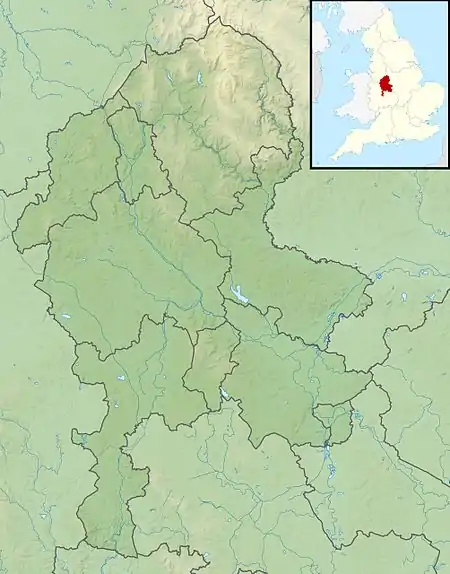Ford Green Brook
Ford Green Brook flows through Staffordshire and the outlying areas of Stoke-on-Trent, England. It is the first named tributary stream of the River Trent, and is 6.2 miles (10 km) long.[1][2]
| Ford Green Brook | |
|---|---|
.jpg.webp) Ford Green Brook near Brindley Ford | |
 Ford Green brook within Staffordshire | |
| Nickname(s) | Banky Brook |
| Location | |
| Country | England |
| Counties | Staffordshire |
| Physical characteristics | |
| Source | |
| • location | Mow Cop |
| Mouth | |
• location | Milton, Staffordshire |
• coordinates | 53.0442°N 2.1453°W |
| Length | 10 km (6.2 mi)[1] |
| Basin size | 15 km2 (5.8 sq mi)[1] |
| Progression : Ford Green Brook—Trent—Humber | |
Course and catchment
Its source is below Mow Cop, on the flank of the gritstone edge on which the village is located. The brook flows south-east in a narrow valley, through Brindley Ford and then into conurbation of Stoke-on-Trent. It passes through the site of the disused Chatterley Whitfield colliery, where it was once culverted, and then flows between Bradeley and Norton-in-the-moors to Ford Green. The brook then flows to the east of Smallthorne, and Sneyd Green where it passes beneath the Caldon Canal, joining the Trent near Milton, Staffordshire.[2]
The catchment, which lies between that of the Head of Trent to the north and east, and that of the Scotia brook to the south and west, has an area of 15 square kilometres (5.8 sq mi). Ford Green valley was at one time the location for heavy industry, with local collieries such as the Chatterley-Whitfield, supplying coal to the Ford Green ironworks.[3]
In their place, a number of parks and wildlife sites have now been created linked together by a cycle route. These include the Chatterley-Whitfield heritage park, the Whitfield Valley nature reserve, and Holden Lane pools.[4][5][6]
Banky Brook
Banky Brook was the traditional name given to the stream as it passed through Stoke. It was a popular place for local children to play in the past. A street in the nearby village of Bradeley is named Banky Brook Close.[7]
Floods
In August 1987, following intense rainfall, the brook overflowed and flooded the 16th century Ford Green Hall an historic house museum. The floods reached a depth of 4–5 feet within the house and antique furniture was seen floating through the lower rooms. The damage caused by the storm meant that the hall had to close for two years whilst it was renovated and repaired.[8]
Wildlife and ecology
Ford Green brook has been classed as having poor ecological quality under the Water Framework Directive. This is one of the lower bands in the five part framework scale, which ranges from high, good, and moderate, through to poor and finally bad.[9]
Despite the low ecological classification, sites along the brook support a variety of flora and fauna, including water voles, grass snakes, and dragonflies. The Ford Green reed bed, at the lower end of Whitfield Valley nature reserve, has been designated as a Site of Special Scientific Interest. This is because substantial flocks of swallows Hirundo rustica congregate here before migrating for the winter.[5][10]
References
- "WFD Surface Water Classification Status and Objectives 2012 csv files". Environment-agency.gov.uk. Archived from the original on 24 February 2014. Retrieved 20 April 2014.
- Ordnance Survey (2006). 118 Stoke-on-Trent & Macclesfield. OS Landranger Map Series. Ordnance Survey. ISBN 9780319229064.
- "Ford Green ironworks". Historical overview / Iron and Steel. Staffs Past Track. Retrieved 14 March 2014.
- "Chatterley-Whitfield country park". Country Parks. Stoke on Trent City Council. Archived from the original on 25 May 2013. Retrieved 14 March 2014.
- "Whitfield Valley". Nature Reserves. Stoke on Trent City Council. Retrieved 14 March 2014.
- "Holden Lane Pools". Nature Reserves. Natural England. Retrieved 14 March 2014.
- "Bradeley". Stoke on Trent Streets. thepotteries.org. Retrieved 14 March 2014.
- "Nostalgia Letter: Extreme floods were a real disaster for many". The Sentinel. 2009. Retrieved 20 March 2014.
- "Water Framework Directive - River Basin Management Plans". What's in your Backyard. Environment Agency. Archived from the original on 4 March 2016. Retrieved 11 March 2014.
- "Whitfield Valley". Local Nature Reserves. Natural England. Retrieved 14 March 2014.